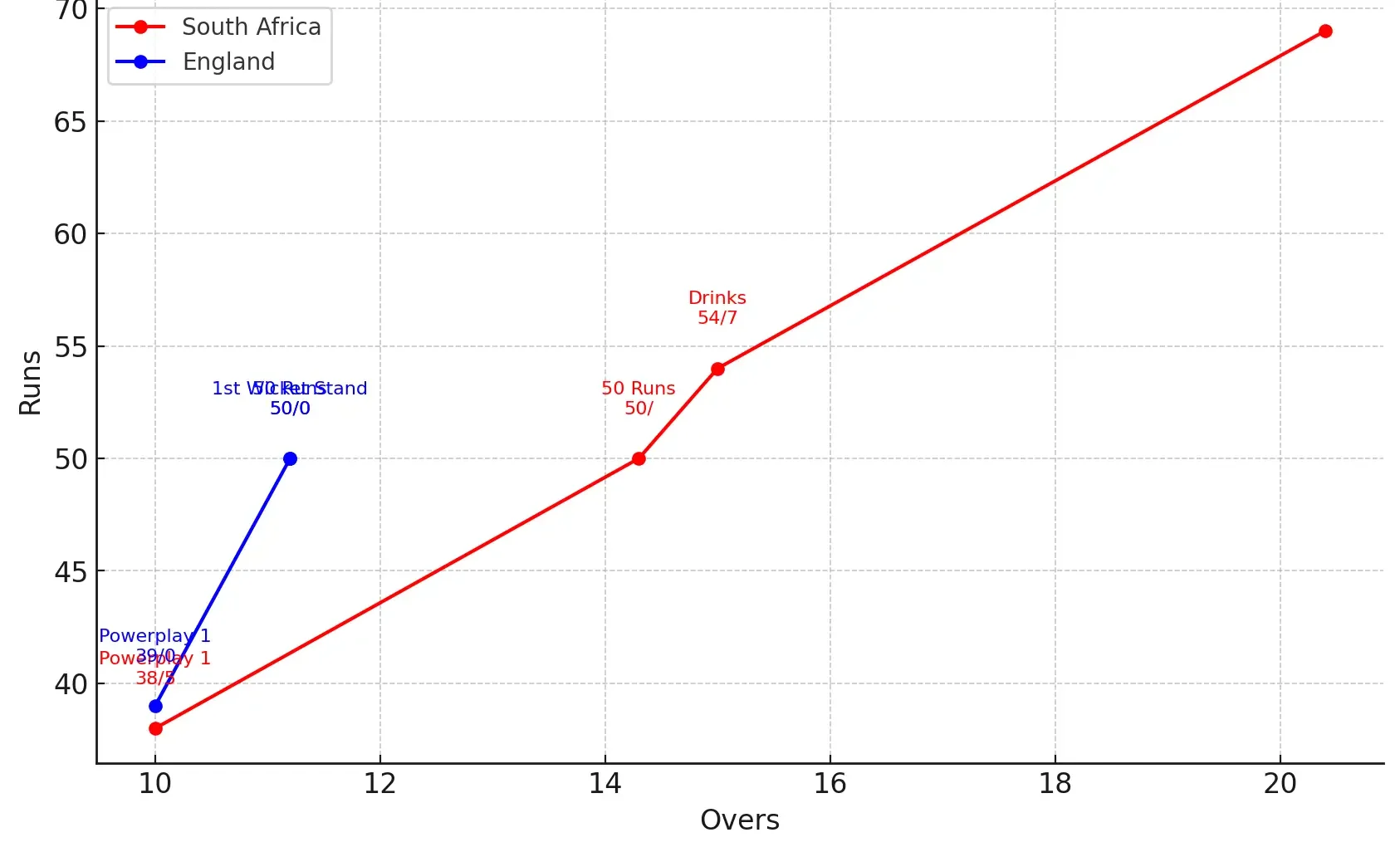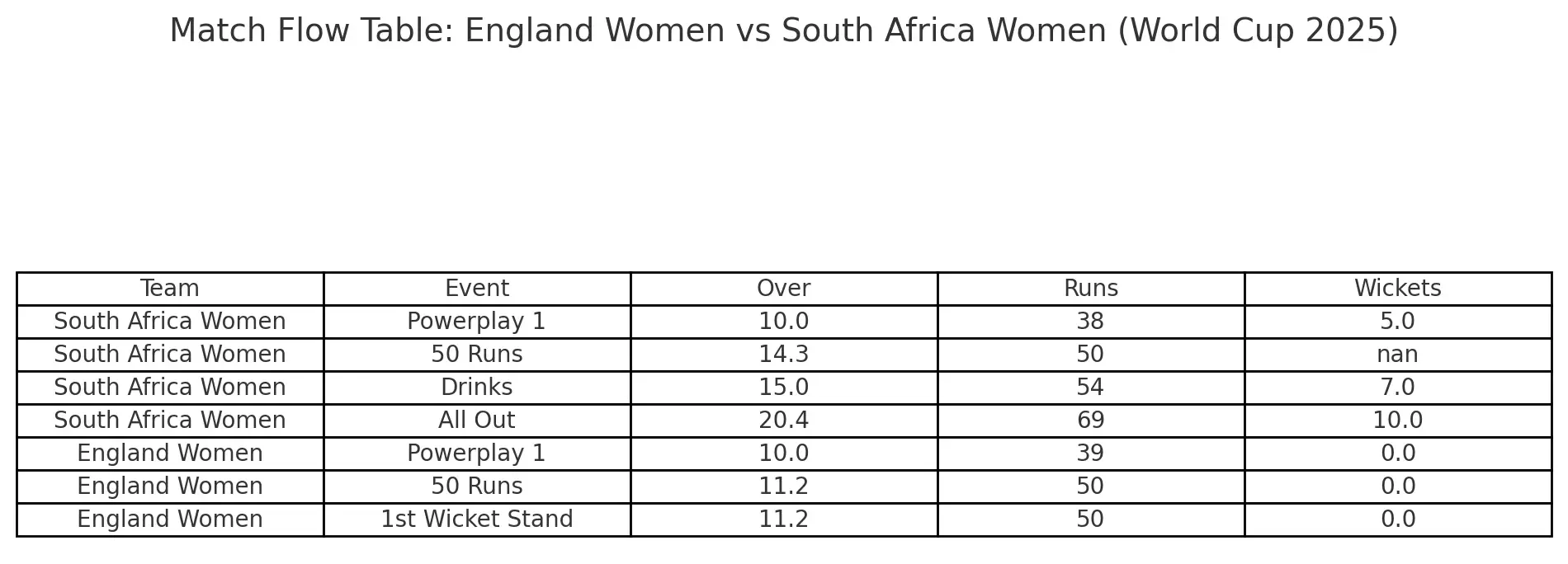Guwahati saw England dismantle South Africa with a bold tactical gamble. They opened the attack with Linsey Smith and trusted her drift immediately. The decision worked as Smith removed Wolvaardt, Brits and Kapp inside powerplay overs. South Africa collapsed to 69 all out and conceded a ten-wicket defeat.
England’s attack mixed left-arm spin with seam swing to unsettle every batter. Laura Wolvaardt’s early dismissal summed up South Africa’s footwork and timing issues. Lauren Bell and Nat Sciver-Brunt then exploited stumps with disciplined seam bowling. The combination of drift and swing left South Africa struggling without answers.
This article moves beyond match recap and looks deeper at planning. We break down Smith’s rise, South Africa’s collapse and England’s opening strategy. Each section highlights what coaches, selectors and players can learn immediately. From nets to selection, the lessons here stretch beyond just one game.
The match proved tactical courage can overwhelm reputation and experience on any day. England trusted their bowlers and executed plans with control and clarity. South Africa must adapt quickly with stronger drills and improved technical focus. Otherwise, tournament hopes could vanish early under repeated batting collapses like this.
Linsey Smith’s Rise: Why England’s Left-Arm Plan Worked Perfectly
Smith’s first spell showed drift, discipline and stumps accuracy from the start. She dismissed Wolvaardt with a return catch and immediately disrupted South Africa’s plans. Then she removed Brits with drift through the gate and Kapp with swing. England’s new-ball gamble had worked perfectly inside the first ten overs.
Coach Charlotte Edwards backed Smith despite her short ODI career and limited exposure. The field placements supported drift, cutting angles and forcing batters into risky strokes. Lauren Bell’s inswing at the other end added perfect complementary pressure. South Africa were 19 for 4 and never recovered from early shocks.
Smith succeeded not through sharp turn but by targeting stumps every ball. On Guwahati conditions, some deliveries kept low and others drifted across pads. That subtle variation demanded precise footwork, which South Africa lacked entirely today. The collapse confirmed both the value of Smith’s selection and England’s planning.
For coaches, Smith’s spell highlights trust, role clarity and pairing strategies. Teams must practise guard checks and drift angles more in competitive nets. Left-arm spin must be part of new-ball scenario planning across tournaments. Tactical innovation wins games when executed as cleanly as England did here.
What Smith’s spell reveals about match planning and skills?
Smith’s impact reinforces the value of diverse bowling angles at the start. Opening with spin forces early footwork tests and limits predictable scoring areas. Batters must decide quickly whether to play forward or leave deliveries. South Africa failed, showing why such angles remain valuable tactical weapons.
Planning involved precise field placements and a seam partner exploiting swing. The pairing denied singles, forced errors and accelerated the collapse quickly. Young bowlers gain belief when trusted in high-pressure roles with clarity. Smith proved once again that patient planning beats reputation in modern cricket.
South Africa’s Technical Collapse: Footwork Failures and Poor Shot Choices
South Africa’s innings collapsed because footwork failed repeatedly against drift. Wolvaardt trained against left-arm bowling but fell to a soft dismissal early. Brits played across the line and exposed her gate to Smith’s drift. Kapp lost her stumps, beaten by subtle swing on a fuller ball.
Batters looked rushed, playing poor shots under pressure without balance. Middle-order players failed to adapt once top-order wickets fell in clusters. The innings had no stabilising partnership and collapsed within 20 overs. South Africa’s batting strength turned fragile, exposing technical gaps already identified before tournaments.
Training preparation was strong, but execution collapsed under actual match intensity. Nets cannot fully simulate pressure created by drift and variable bounce. Coaches must insist on simulated match scenarios against left-arm spin and swing. Selection may shift towards batters with stable front-foot and back-foot mechanics.
The collapse was not about pitch demons but technical failures under stress. Batters reverted to unsafe lines despite clear preparation against drift angles. That shows mental lapses often outweigh technical practice during match pressure. South Africa must urgently fix this before their next group fixture.
England Women vs South Africa Women, 4th Match at Guwahati, Women’s World Cup, Oct 03 2025 – Full Scorecard
South Africa Women (50 ovs maximum)
| Batting | R | B | M | 4s | 6s | SR | |||
|---|---|---|---|---|---|---|---|---|---|
|
Laura Wolvaardt (c)
|
c & b Smith | 5 | 5 | 6 | 1 | 0 | 100.00 | ||
|
Tazmin Brits
|
b Smith | 5 | 7 | 13 | 1 | 0 | 71.42 | ||
|
Sune Luus
|
b Bell | 2 | 11 | 13 | 0 | 0 | 18.18 | ||
|
Marizanne Kapp
|
b Smith | 4 | 6 | 10 | 1 | 0 | 66.66 | ||
|
Anneke Bosch
|
lbw b Nat Sciver-Brunt | 6 | 5 | 14 | 1 | 0 | 120.00 | ||
|
Sinalo Jafta †
|
b Ecclestone | 22 | 36 | 46 | 3 | 0 | 61.11 | ||
|
Chloe Tryon
|
c Capsey b Nat Sciver-Brunt | 2 | 10 | 7 | 0 | 0 | 20.00 | ||
|
Nadine de Klerk
|
c Knight b Ecclestone | 3 | 11 | 11 | 0 | 0 | 27.27 | ||
|
Masabata Klaas
|
b Dean | 3 | 13 | 11 | 0 | 0 | 23.07 | ||
|
Ayabonga Khaka
|
not out | 6 | 12 | 13 | 1 | 0 | 50.00 | ||
|
Nonkululeko Mlaba
|
b Dean | 3 | 8 | 10 | 0 | 0 | 37.50 | ||
| Extras | (w 8) | 8 | |||||||
| Total |
20.4 Ov (RR: 3.33)
|
69 | |||||||
|
Fall of wickets: 1-9 (Laura Wolvaardt, 1.2 ov), 2-12 (Tazmin Brits, 3.1 ov), 3-17 (Sune Luus, 4.4 ov), 4-19 (Marizanne Kapp, 5.1 ov), 5-31 (Anneke Bosch, 8.1 ov), 6-38 (Chloe Tryon, 10.1 ov), 7-48 (Nadine de Klerk, 13.1 ov), 8-60 (Masabata Klaas, 16.5 ov), 9-60 (Sinalo Jafta, 17.3 ov), 10-69 (Nonkululeko Mlaba, 20.4 ov) • DRS
|
|||||||||
| Bowling | O | M | R | W | ECON | 0s | 4s | 6s | WD | NB |
|---|---|---|---|---|---|---|---|---|---|---|
|
Lauren Bell
|
4 | 0 | 24 | 1 | 6.00 | 15 | 4 | 0 | 1 | 0 |
|
Linsey Smith
|
4 | 2 | 7 | 3 | 1.75 | 22 | 1 | 0 | 0 | 0 |
|
Nat Sciver-Brunt
|
3 | 1 | 5 | 2 | 1.66 | 14 | 0 | 0 | 1 | 0 |
|
Sophie Ecclestone
|
6 | 2 | 19 | 2 | 3.16 | 25 | 1 | 0 | 1 | 0 |
|
Charlie Dean
|
3.4 | 0 | 14 | 2 | 3.81 | 15 | 2 | 0 | 1 | 0 |
England Women (T: 70 runs from 50 ovs)
| Batting | R | B | M | 4s | 6s | SR | |||
|---|---|---|---|---|---|---|---|---|---|
|
Tammy Beaumont
|
not out | 21 | 35 | 58 | 3 | 0 | 60.00 | ||
|
Amy Jones †
|
not out | 40 | 50 | 58 | 6 | 0 | 80.00 | ||
| Extras | (lb 3, w 9) | 12 | |||||||
| Total |
14.1 Ov (RR: 5.15)
|
73/0 | |||||||
|
Did not bat: Heather Knight,
Nat Sciver-Brunt (c),
Sophia Dunkley,
Emma Lamb,
Alice Capsey,
Charlie Dean,
Sophie Ecclestone,
Linsey Smith,
Lauren Bell
|
|||||||||
| DRS | |||||||||
| Bowling | O | M | R | W | ECON | 0s | 4s | 6s | WD | NB |
|---|---|---|---|---|---|---|---|---|---|---|
|
Marizanne Kapp
|
4 | 0 | 13 | 0 | 3.25 | 16 | 1 | 0 | 0 | 0 |
|
Chloe Tryon
|
3 | 0 | 17 | 0 | 5.66 | 13 | 2 | 0 | 2 | 0 |
|
Masabata Klaas
|
4 | 0 | 18 | 0 | 4.50 | 13 | 1 | 0 | 3 | 0 |
|
Nonkululeko Mlaba
|
2 | 1 | 9 | 0 | 4.50 | 9 | 2 | 0 | 0 | 0 |
|
Ayabonga Khaka
|
1.1 | 0 | 13 | 0 | 11.14 | 3 | 3 | 0 | 0 | 0 |
- South Africa Women’s innings
- Powerplay 1: Overs 0.1 – 10.0 (Mandatory – 38 runs, 5 wickets)
- South Africa Women: 50 runs in 14.3 overs (87 balls), Extras 7
- Drinks: South Africa Women – 54/7 in 15.0 overs (S Jafta 19, M Klaas 1)
- Innings Break: South Africa Women – 69/10 in 20.4 overs (A Khaka 6)
- England Women innings
- Powerplay 1: Overs 0.1 – 10.0 (Mandatory – 39 runs, 0 wicket)
- Over 4.5: Review by South Africa Women (Bowling), Decision Challenged – Wicket, Umpire – Shathira Jakir, Batter – TT Beaumont (Struck down)
- England Women: 50 runs in 11.2 overs (68 balls), Extras 10
- 1st Wicket: 50 runs in 68 balls (TT Beaumont 13, AE Jones 27, Ex 10)
How preparation fell short under combined spin and seam pressure?
Nets had simulated left-arm spin but not under extreme match scenarios. Players rehearsed, yet timing errors persisted when Smith and Sciver-Brunt combined. Coaches must increase live-match simulations replicating drift and seam together. Without those, execution lapses will continue under pressure.
South Africa’s preparation looked detailed but missed adaptability drills under live stress. Players need to practice leaving balls and defending with soft hands. Rehearsing recovery plans when clusters of wickets fall must be a priority. Without this, collapses will repeat against disciplined new-ball plans.
England’s Tactical Masterclass: Opening with Spin and Supporting Pace
England’s biggest success came from pairing Smith’s drift with Bell’s inswing. This new-ball strategy targeted stumps relentlessly and denied easy scoring chances. Sciver-Brunt followed with accuracy, closing the innings quickly and cheaply. South Africa were outplayed tactically from the first over itself.
Opening with spin unsettled batters mentally and forced quick misjudgments. The seamers then exploited that uncertainty with tight stumps-focused bowling. England’s bowlers varied pace, flight and line, preventing rhythm from developing. The strategy blended risk-taking with precise execution across all overs.
Coaches must study England’s pairing concept for tactical innovation in ODIs. Left-arm spin combined with new-ball seam can produce consistent early breakthroughs. Data analysis on drift angles and contact points should guide pair selection. England showed boldness backed by data can alter whole match narratives.
South Africa looked surprised and unable to adapt quickly under pressure. Their batters missed early cues and failed to re-adjust footwork. England executed an unusual plan but with discipline and composure. That balance of innovation and control defined this Guwahati masterclass performance.
Lessons for coaches: pairing bowlers and new-ball strategies
Bowler pairing depends on conditions, opposition and match context always. England matched Smith’s drift with Bell’s swing for perfect synergy today. Practice nets should replicate such pairings under pressure situations. Teams must train players to expect spin openings in tournaments.
Data-driven planning will become essential for opening bowling strategies in ODIs. Coaches should measure drift, release points and seam angles during training. Tactical flexibility beats rigid plans when conditions allow experimentation. England’s boldness rewarded them with dominance and top spot in standings.
Conclusion
England’s Guwahati win delivered tactical lessons for every international team. Smith’s trust and execution validated the strategy of opening with spin. Bell and Sciver-Brunt reinforced plans with swing and accuracy. South Africa’s collapse exposed technical flaws and mental lapses under pressure.
South Africa must fix footwork, guard discipline and adaptability urgently. Coaches should simulate drift-heavy nets and enforce recovery drills under pressure. Selection must focus on batters who show reliable defensive mechanics. Without this, more collapses could follow against tournament-quality opposition.
England’s performance will reshape how teams approach opening strategies in ODIs. Spin openings with left-arm angles could become more common now. Data-driven plans and pairings will dominate modern limited-overs coaching. Execution remains key, but boldness creates opportunities to control games early.
For context on historical collapses and improvements, see the India vs Bangladesh timeline. Teams must embrace lessons and act quickly to avoid repeated errors. This match will stand as an example of tactical clarity and execution. England proved courage and planning can dismantle reputations in just 20 overs.









